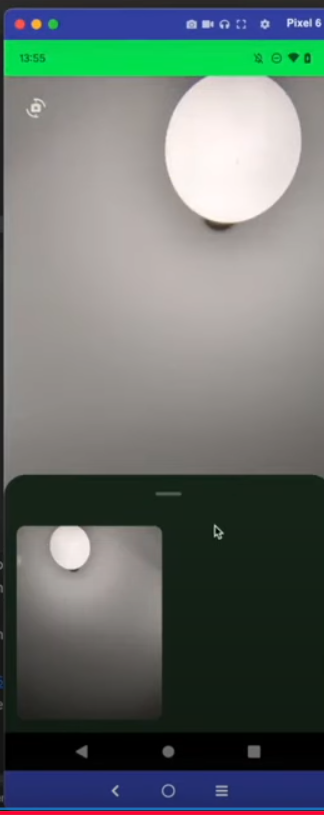Android CameraX
Introduction
Already had this working for my Food app but this is now broken so watching a tutorial and thought I better take notes
Setup Permissions
Make sure we give permissions in the Manifest
<uses-feature
android:name="android.hardware.camera"
android:required="false" />
<uses-permission android:name="android.permission.CAMERA" />
<uses-permission android:name="android.permission.RECORD_AUDIO" />
Implement Permission Checking
This is the simplest way to get going
class MainActivity : ComponentActivity() {
override fun onCreate(savedInstanceState: Bundle?) {
super.onCreate(savedInstanceState)
if (!hasRequiredPermissions()) {
requestPermissions(CAMERAX_PERMISSIONS, 0)
}
enableEdgeToEdge()
}
private fun hasRequiredPermissions(): Boolean {
return CAMERAX_PERMISSIONS.all {
ContextCompat.checkSelfPermission(this, it) == PackageManager.PERMISSION_GRANTED
}
}
companion object {
private val CAMERAX_PERMISSIONS = arrayOf(
android.Manifest.permission.CAMERA,
android.Manifest.permission.RECORD_AUDIO
)
}
@Composable
fun Greeting(name: String, modifier: Modifier = Modifier) {
Text(
text = "Hello $name!",
modifier = modifier
)
}
}
Compose
I am loving the new compose. It takes a lot of the tedium out of it all. This did not exist last time. Basically bye, bye XML. Lot of code here but you just make the bits and add the components inline. The CameraPreview is the implementation of the previewer in Xml. This
setContent {
CameraXTutTheme {
Scaffold {
val scaffoldState = rememberBottomSheetScaffoldState()
val controller = remember {
LifecycleCameraController(applicationContext).apply {
setEnabledUseCases(
CameraController.IMAGE_CAPTURE or
CameraController.VIDEO_CAPTURE
)
}
}
BottomSheetScaffold(
scaffoldState = scaffoldState,
sheetPeekHeight = 0.dp,
sheetContent = {
}
) { padding ->
Box(
modifier = Modifier
.fillMaxSize()
.padding(padding)
) {
CameraPreview(
controller,
Modifier.fillMaxSize()
)
IconButton(
onClick = {
controller.cameraSelector =
if (controller.cameraSelector == CameraSelector.DEFAULT_BACK_CAMERA) {
CameraSelector.DEFAULT_FRONT_CAMERA
} else {
CameraSelector.DEFAULT_BACK_CAMERA
}
},
modifier = Modifier.padding(16.dp)
) {
Icon(
imageVector = Icons.Default.Cameraswitch,
contentDescription = "Switch Camera"
)
}
Row(
modifier = Modifier
.fillMaxWidth()
.align(Alignment.BottomCenter)
.padding(16.dp),
horizontalArrangement = Arrangement.SpaceAround
) {
IconButton(
onClick = {
}
) {
Icon(
imageVector = Icons.Default.Photo,
contentDescription = "Open Gallery"
)
}
IconButton(
onClick = {
}
) {
Icon(
imageVector = Icons.Default.PhotoCamera,
contentDescription = "Take Photo"
)
}
}
}
}
}
}
}
Add A Panel (Sheet) to Display Taken Images
First we create a sheet to display the images take on, this really is an excuse to document something to remind me what to do
@Composable
fun PhotoBottomSheetContent(
bitmaps: List<Bitmap>,
modifier: Modifier
) {
if(bitmaps.isEmpty()) {
Box(
modifier = modifier
.padding(16.dp),
contentAlignment = Alignment.Center
)
{
Text ("No photos taken yet")
}
} else {
LazyVerticalStaggeredGrid(
columns = StaggeredGridCells.Fixed(2),
horizontalArrangement = Arrangement.spacedBy(16.dp),
verticalItemSpacing = 16.dp,
contentPadding = PaddingValues(16.dp),
modifier = modifier
) {
items(bitmaps) { bitmap ->
Image(
bitmap = bitmap.asImageBitmap(),
contentDescription = null,
modifier = Modifier
.clip(RoundedCornerShape(10.dp))
)
}
}
}
}
This is the code for the Panel is this photo

Taking A Photo
Glad I watched this course, the compose stuff looks like it will improve people speed a lot. Next take the photo and you can see this is now trivial.
Make A Model for the View
We create a model of type MutableStateFlow to store the collected images
class MainViewModel : ViewModel() {
private val _bitmaps = MutableStateFlow<List<Bitmap>>(emptyList())
val bitmaps = _bitmaps.asStateFlow()
fun onTakePhoto(bitmap: Bitmap) {
Log.i("CameraXTut", "Adding a photo")
_bitmaps.value += bitmap
}
Attach the onTakePhoto to the onPhotoTaken delegate
When we take a photo, it is added to the model
IconButton(
onClick = {
takePhoto(
controller = controller,
onPhotoTaken = viewModel::onTakePhoto
)
}
) {
Icon(
imageVector = Icons.Default.PhotoCamera,
contentDescription = "Take Photo"
)
}
Taking the Photo
And here is the function which takes the photo
private fun takePhoto(
controller: LifecycleCameraController,
onPhotoTaken: (Bitmap) -> Unit
) {
controller.takePicture(
ContextCompat.getMainExecutor(applicationContext),
object: OnImageCapturedCallback() {
override fun onCaptureSuccess(image: ImageProxy) {
onPhotoTaken(image.toBitmap())
Log.i("CameraXTut", "Taken a picture")
}
override fun onError(exception: ImageCaptureException) {
super.onError(exception)
Log.e("CameraXTut", "Error capturing image", exception)
}
}
)
}
Rotating and Flipping the image
When you take the photo you need to handle to flipping of the image based on the camera which is used.
override fun onCaptureSuccess(image: ImageProxy) {
// Flip the image if it's from the front camera
val isFrontCamera = controller.cameraSelector == CameraSelector.DEFAULT_FRONT_CAMERA
onPhotoTaken(rotateImage(image, isFrontCamera))
Log.i("CameraXTut", "Taken a picture")
}
We create a matrix, getting the number of degrees to rotate, then create a bitmap based on this matrix
private fun rotateImage(image: ImageProxy, flipImage: Boolean ): Bitmap {
val matrix = Matrix().apply {
postRotate(image.imageInfo.rotationDegrees.toFloat())
if(flipImage) {
postScale(-1f, 1f)
}
}
return Bitmap.createBitmap(
image.toBitmap(),
0,
0,
image.width,
image.height,
matrix,
true
)
}
Recording a Video
This could not be easier, its like they want you to use their product. Create a recording object.
private var recording: Recording? = null
Create a button
IconButton(
onClick = {
recordVideo(controller = controller)
}
) {
Icon(
imageVector = Icons.Default.Videocam,
contentDescription = "Record Video"
)
}
Write the function which, checks for permissions, either stops or starts video recording
@SuppressLint("MissingPermission")
private fun recordVideo(
controller: LifecycleCameraController,
) {
if(!hasRequiredPermissions()) {
requestPermissions(CAMERAX_PERMISSIONS, 0)
return
}
// Check if we're already recording, and stop if we are
if (recording != null) {
recording?.stop()
recording = null
return
}
val outputFile = File(filesDir, "video.mp4")
recording = controller.startRecording(
FileOutputOptions.Builder(outputFile).build(),
AudioConfig.create(true),
ContextCompat.getMainExecutor(applicationContext)
) { event ->
when (event) {
is VideoRecordEvent.Finalize -> {
if (event.hasError()) {
recording?.close()
recording = null
Toast.makeText(
applicationContext,
"Error recording video",
Toast.LENGTH_LONG
).show()
} else {
Toast.makeText(applicationContext, "Video saved", Toast.LENGTH_LONG).show()
}
}
}
}
}